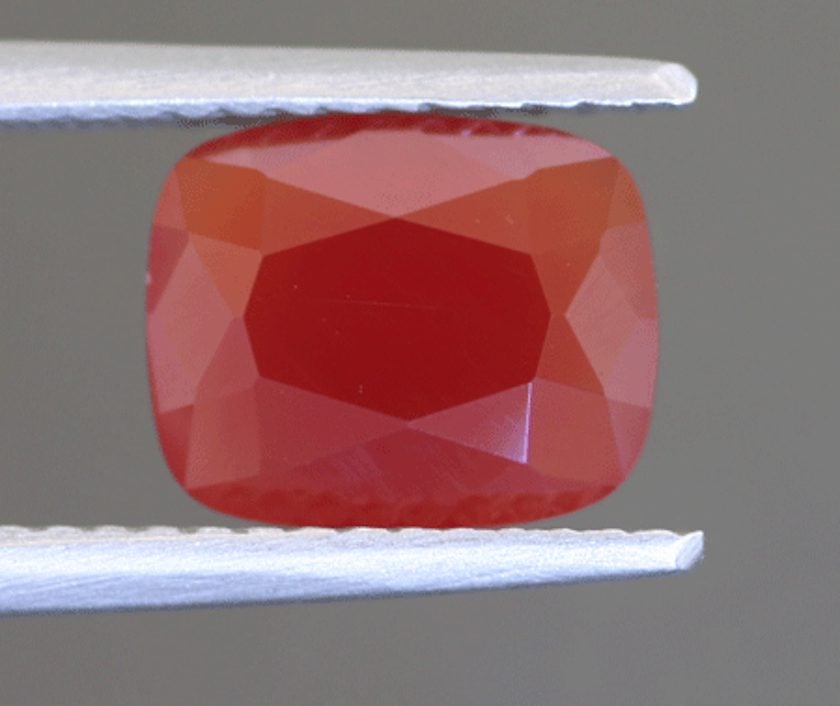Friedelite Value, Price, and Jewelry Information
Friedelite is not abundant, and gem-quality material is rarely seen even in large collections. Faceted gems are true collector's items.
1 Minute Read
Friedelite is not abundant, and gem-quality material is rarely seen even in large collections. Faceted gems are true collector’s items.
Start an IGS Membership today
for full access to our price guide (updated monthly).Friedelite Value
Comments
Lovely friedelite cabochons cut from Franklin, New Jersey material show rich, brownish red colors, while cabs cut from material from the deep manganese mine at Kuruman, South Africa show rose-red colors. Cut stones from both these locations are usually translucent. However, gem cutters have faceted very little of this material.
Friedelite belongs to the pyrosmalite mineral group, which includes schallerite and pyrosmalite.
Identifying Characteristics
Refractometer readings usually show a shadow edge at about 1.645.
Synthetics
No known synthetics.
Sources
Franklin, New Jersey produces gem-quality material, typically brownish and cryptocrystalline, that looks like fibrous chalcedony. Seams of the material at this deposit range up to 2 inches wide. Most gem-quality friedelites come from this location.
Kuruman, South Africa produces massive, dark rose-red material.
Other notable sources of this mineral include the following:
- Austria; Adervielle, France; Kazahkstan; Orebro, Sweden.
Stone Sizes
Translucent stones can normally range up to 1 to 5 carats in size. Although cabochons can be cut to about 30 x 40 mm, larger stones lose any transparency.
Care
You're more likely to find friedelites, if at all, in mineral collections than in jewelry collections. These gems have significantly lower hardness (4-5) than more common jewelry stones. So, store them separately from other gems to avoid contact scratches. Use protective settings for ring wear. However, necklace and earring use should pose fewer risks. Clean these gems only with a soft brush, mild detergent, and warm water. Consult our gemstone jewelry cleaning guide for more recommendations.
Joel E. Arem, Ph.D., FGA
Dr. Joel E. Arem has more than 60 years of experience in the world of gems and minerals. After obtaining his Ph.D. in Mineralogy from Harvard University, he has published numerous books that are still among the most widely used references and guidebooks on crystals, gems and minerals in the world.
Co-founder and President of numerous organizations, Dr. Arem has enjoyed a lifelong career in mineralogy and gemology. He has been a Smithsonian scientist and Curator, a consultant to many well-known companies and institutions, and a prolific author and speaker. Although his main activities have been as a gem cutter and dealer, his focus has always been education. joelarem.com
International Gem Society
Related Articles
Black Diamond Value, Price, and Jewelry Information
Chameleon Diamond Value, Price, and Jewelry Information
Gray Diamond Value, Price, and Jewelry Information
Green Diamond Value, Price, and Jewelry Information
Latest Articles
Amethyst Sources Around the World: The Geological Story Behind These Purple Gemstones
Brazilianite Value, Price, and Jewelry Information
Ruby-Glass Composites vs Leaded Glass Clarity Enhancements
Morganite Buying Guide
Never Stop Learning
When you join the IGS community, you get trusted diamond & gemstone information when you need it.
Get Gemology Insights
Get started with the International Gem Society’s free guide to gemstone identification. Join our weekly newsletter & get a free copy of the Gem ID Checklist!
